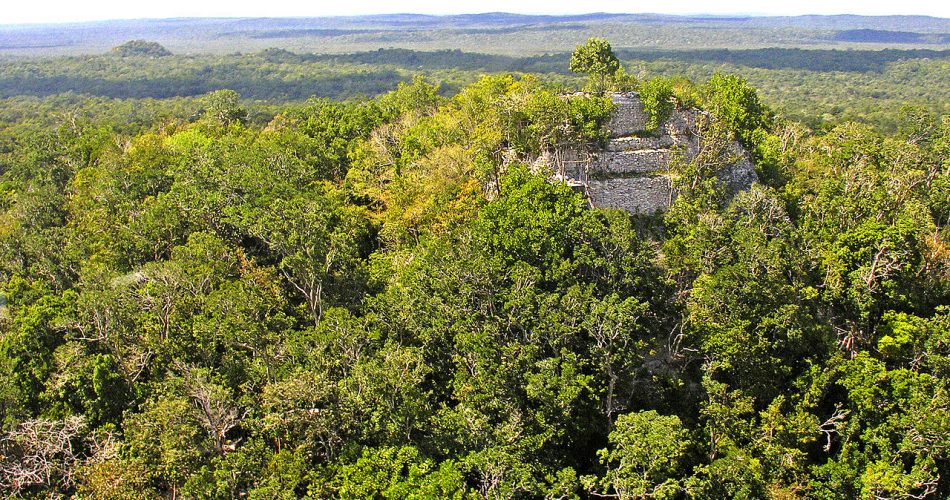- The Pyramid of La Danta is even larger than Egypt’s Great Pyramid. La Danta’s total volume is measured at around 2,800,000 cubic meters.
- The Pyramid is one of the largest in the world, together with Cholula’s Great Pyramid.
- The massive pyramid is one of the largest ancient structures on Earth and was built in the ancient Maya city of El Mirador, a metropolis of the Maya which thrived from the sixth through the third centuries BC.
- The city has long been retaken by nature and only a small part of it is visible from a distance.
There’s an ancient city that once belonged to the Maya civilization hidden away in the north of present-day Guatemala.
Thousands of ancient structures lay tucked away in a region called el Peten. There, under a thick canopy of the Guatemalan rainforest are the remnants of a long-lost city, home to one of the largest pyramids the world has ever seen. Its glory may have disappeared long ago, but its history is written in stone.
The ancient city of the Maya is thought to have flourished from around the 6th century BC to the 1st century CE, and probably reached its height around the 3rd century BC. Then it experienced a hiatus of construction and perhaps abandonment for generations. The city was reoccupied and expanded, starting from the Late Classic Era. The city would eventually be abandoned for good sometime at the end of the ninth century.
The ancient city of El Mirador, which translates into the viewpoint or lookout, covered more than 10 square miles (26 square kilometers). Some of its tallest monuments reached heights of more than 70 meters in height.
Today the city is barely visible. In fact, you could probably walk not far from it and never notice it was there. That’s because the ancient city and its massive monuments have long been reclaimed by nature.
Although only vestiges of a once-great city remain today, the city was inhabited by the thousands in the distant past.
The city was by no means small, and like many other ancient Maya cities, this too developed into a sprawling metropolis. Despite the tropical forest soil lacked many necessary nutrients for crops to flourish, the inhabitants of El Mirador developed techniques that allowed them to feed a growing population by creating a system based on swamps. The ancient Maya imported mud from nearby swamps ( in the thousands of tons) creating mud-covered terraces that were essentially ready for agriculture. They added lime to the soil in order to elevate the pH, making their gardens suitable for growing a great variety of crops including corn, beans, cacao, squash, and cotton among others.
This flourishing agriculture allowed the city to grow, not only socially, but also economically and architecturally.
La Danta Pyramid and El Mirador
The ancient city is home to as many as thirty-five triadic structures which are made up of massive artificial platforms topped with a series of 3 summit pyramids. The largest of such structures are El Tigre which a height of 55 meters (180 ft) and La Danta.
La Danta is by far the most impressive of them all, and we could say it is one of the largest ever erected in the Maya world. Dubbed the La Danta temple or La Danta Pyramid, the structure measures around 72 meters in height, rising from the rainforest floor. Estimates of its size suggest the structure has a total volume of 2,800,000 cubic meters, which means it is one of the largest pyramids in the world, even larger than the Great Pyramid of Giza which has a total volume of 2,583,283 cubic meters.
La Danta is truly massive. When the large man-made platform that the temple is built upon (approximately 180,000 square meters) is taken into consideration when calculating its total volume, the Pyramid of La Danta is then one of the most massive ancient structures ever built in the world.
As one of the world’s largest structures, and given its age, La Danta is certainly one of the most mysterious pyramids built on Earth. It remains a profound mystery how the ancient Maya managed to erect such a massive temple in the distant past. Experts have calculated that around 15 million man-days of labor were needed to construct a pyramid of the size of La Danta.
Richard D. Hansen from the Idaho State University has calculated the volume and labor expended in the construction of La Danta, which represents approximately 2,816,016 cubic meters, unless there is a topographic anomaly, such as a natural hill inside. Using calculations derived from current archaeological expeditions, Hansen has identified an amount of 6,730,769 man-days of labor only in the transportation of the material (mud and stone) for the landfill, that is, 1,000 workers working 18.44 years only in the landfill transport.
The degree of difficulty in building such a massive structure is even more emphasized by the fact that when the pyramid was built, the ancient Maya did not have pack animals such as horses, oxen nor mules. In addition to the lack of pack animals, the Maya who are thought to have built the pyramids did so without using technologies such as the wheel.
Despite these disadvantages, the ancient Maya managed to erect what is now considered one of the most complex representations of ancient Maya architecture.
Thankfully, like many other pyramids around the world, this structure too has stood the test of time, and we can appreciate it today.
Climbing the massive pyramid takes time, however, once atop it, the visitor is rewarded with a striking view of the Guatemalan rainforest and the massive city that hides beneath the trees.
Curiously, there are no written records that tell us anything about the pyramid’s construction, how it was accomplished, using what tools, nor do we know its exact purpose.
However, since many Mesoamerican pyramids served as religious centers or temples, it is believed that La Danta too may have served a similar purpose. Together with the Great Pyramid of Cholula, in present-day Mexico, La Danta is one of the largest pyramids ever erected in Mesoamerica.

